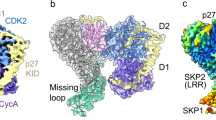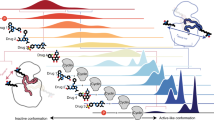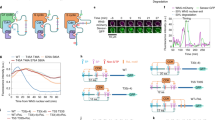Abstract
Cyclin-dependent kinases (CDKs), which play a key role in cell cycle control, are activated by the CDK activating kinase (CAK), which activates cyclin-bound CDKs by phosphorylation at a specific threonine residue. Vertebrate CAK contains two key components: a kinase subunit with homology to its substrate CDKs and a regulatory subunit with homology to cyclins. We have determined the X-ray crystal structure of the regulatory subunit of CAK, cyclin H, at 2.6 Å resolution. Cyclin H contains two α-helical core domains with a fold similar to that of cyclin A, a regulatory subunit of CAK substrate CDK2, and of TFIIB, a transcription factor. Outside of the core domains, the N- and C-terminal regions of the three structures are completely different. The conformational differences between cyclin H and A structures may reflect functional differences between the two cyclins.
This is a preview of subscription content, access via your institution
Access options
Subscribe to this journal
Receive 12 print issues and online access
$189.00 per year
only $15.75 per issue
Buy this article
- Purchase on Springer Link
- Instant access to full article PDF
Prices may be subject to local taxes which are calculated during checkout
Similar content being viewed by others
References
Norbury, C. & Nurse, P. Animal cell cycles and their control. Annu. rev. Biochem. 61, 441–470 (1992).
Nasmyth, K. Control of the yeast cell cycle by the Cdc28 protein kinase. Curr. opin. Cell Biol. 5, 166–179 (1993).
Morgan, D.O. Principles of CDK regulation. Nature 374, 131–134 (1995).
Lees, E. Cyclin dependent kinase regulation. Curr. opin. Cell Biol. 7, 773–780 (1995).
Fesquet, D. et al. The MO15 gene encodes the catalytic subunit of a protein kinase that activates cdc2 and other cyclin-dependent kinases (CDKs) through phosphorylation of Thr 161 and its homologues. EMBO J. 12, 3111–3121 (1993).
Poon, R.Y.C., Yamashita, K., Adamczewski, J.P., Hunt, T. & Shuttleworth, J. The cdc2-related protein p40M015 is the catalytic subunit of a protein kinase that can activate p33cdk2 and p34cdc2. EMBO J. 12, 3123–3132 (1993).
Solomon, M.J., Harper, J.W. & Shuttleworth, J. CAK, the p34 (cdc2) activating kinase, contains a protein identical or closely related to p40 (M015). EMBO J. 12, 3133–3142 (1993).
Fisher, R.P. & Morgan, D.O. A novel cyclin associates with MO15/CDK7 toformtheCDK-activating kinase. Cell 78, 713–724 (1994).
Makela, T.P. et al. A cyclin associated with the CDK-activating kinase MO15. Nature 371, 254–257 (1994).
Fisher, R.P., Jin, P., Chamberlin, H.M. & Morgan, D.O. Alternative mechanisms of CAK assembly require an assembly factor or an activating kinase. Cell 83, 47–57 (1995).
Devault, A. et al. MAT1 (‘Menage à trios’) a new RING finger protein subunit stabilizing cyclin H-CDK7 complexes in starfish and xenopus CAK. EMBO J. 14, 5027–5036 (1995).
Tassan, J.P. et al. In vitro assembly of a functional human CDK7-cylin H complex requires MAT1, a novel 36 kDa RING finger protein. EMBO J. 14, 5608–5617 (1995).
Roy, R. et al. The MO15 cell cycle kinase is associated with the TFIIH transcription-DNA repair factor Cell 79, 1093–1101 (1994).
Serizawa, H. et al. Association of Cdk-activating kinase subunits with transcription factor TFIIH. Nature 374, 280–282 (1995).
Shiekhattar, R. et al. Cdk-activating kinase complex is a component of human transcription factor TFIIH. Nature 374, 283–287 (1995).
Jeffrey, P.D. et al. Mechanism of CDK activation revealed by the structure of a cyclin A-CDK2 complex. Nature 376, 313–320 (1995).
Brown, N.R. et al. The crystal structure of cyclin A. Structure 3, 1235–1247 (1995).
Nikolov, D.B. et al. Crystal structure of a TFIIB-TBP-TATA-element ternary complex. Nature 377, 119–128 (1995).
Bagby, S. et al. Solution structure of the C-terminal core domain of human TFIIB: similarity to cyclin A and interaction with TATA-binding protein. Cell 82, 857–867 (1995).
Nugent, J.H.A., Alfa, C.E., Young, T. & Hyams, J.S. Conserved structural motifs in cyclins identified by sequence analysis. J. cell Sci. 99, 669–674 (1991).
Jancarik, J. & Kim, S.-H. Sparse matrix sampling: a screening method for crystallization of proteins. J. appl. Crystallogr. 24, 409–411 (1991).
Otwinowski, Z. Oscillation data reduction program, in Data collection and Processing (eds. Sawyer, L, Isaacs, N. & Bailey, S.) 56–62 (SERC Daresbury Laboratory, Warrington, England, 1993).
Collaborative computing project No. 4 The CCP4 suite: programs for protein crystallography. Acta crystallogr. D50, 760–763 (1994).
Cowtan, K.D. Improvement of macromolecular electron-density maps by the simultaneous application of real and reciprocal space constraints. Acta crystallogr. D49, 148–157 (1993).
Jones, T.A., Zou, J.-Y., Cowan, S.W. & Kjeldgaard, M. Improved methods for binding protein models in electron density maps and the location of errors in these models. Acta crystallogr. A47, 110–119 (1991).
Brünger, A.T. X-PLOR, version 3.1. a system for X-ray crystallography and NMR (Yale Univ. Press, New Haven, CT, 1993).
Brünger, A.T. The free R value: a novel statistical quantity for assessing the accuracy of crystal structures. Nature 355, 472–475 (1992).
Laskowski, R.A., MacArthur, M.W., Moss, D.S. & Thronton, J.M. PROCHECK - a program to check the stereochemical quality of protein structures. J. appl. Crystallogr. 26, 283–291 (1993).
Kraulis, P.J. MOLSCRIPT - a program to produce both detailed and schematic plots of protein structures. J. appl. Crystallogr. 24, 946–950 (1991).
Author information
Authors and Affiliations
Rights and permissions
About this article
Cite this article
Kim, K., Chamberlin, H., Morgan, D. et al. Three-dimensional structure of human cyclin H, a positive regulator of the CDK-activating kinase. Nat Struct Mol Biol 3, 849–855 (1996). https://doi.org/10.1038/nsb1096-849
Received:
Accepted:
Issue Date:
DOI: https://doi.org/10.1038/nsb1096-849
This article is cited by
-
Structural basis of transcription initiation by RNA polymerase II
Nature Reviews Molecular Cell Biology (2015)
-
Human and mouse cyclin D2 splice variants: transforming activity and subcellular localization
Oncogene (2008)
-
A central domain of cyclin D1 mediates nuclear receptor corepressor activity
Oncogene (2005)
-
p27 binds cyclin–CDK complexes through a sequential mechanism involving binding-induced protein folding
Nature Structural & Molecular Biology (2004)
-
Conditional transformation of rat embryo fibroblast cells by a cyclin D1-cdk4 fusion gene
Oncogene (1999)



